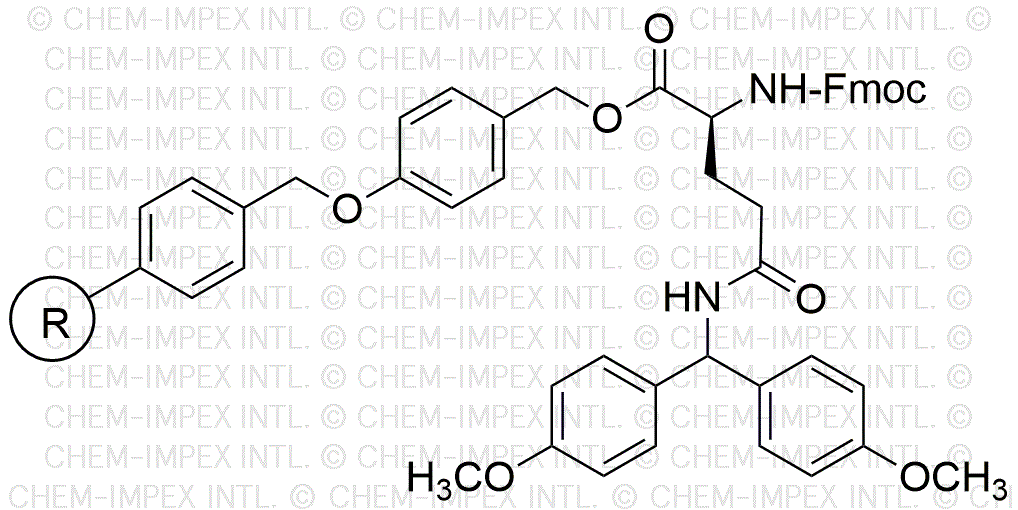Na-Fmoc-Nd-4,4'-dimethoxybenzhydryl-L-glutamine 4-alkoxybenzyl alcohol resin is widely utilized in research focused on:
- Peptide Synthesis: This resin is essential for solid-phase peptide synthesis, allowing researchers to efficiently create complex peptides with high purity and yield.
- Drug Development: It plays a crucial role in the pharmaceutical industry for developing peptide-based drugs, enabling the exploration of new therapeutic options.
- Bioconjugation: The resin is used in bioconjugation processes, facilitating the attachment of peptides to other molecules, enhancing drug delivery systems.
- Protein Engineering: Researchers utilize this resin in protein engineering to modify proteins for better functionality, stability, or targeting capabilities.
- Academic Research: It serves as a valuable tool in academic laboratories for studying protein interactions and functions, contributing to advancements in biochemistry and molecular biology.
General Information
Properties
Safety and Regulations
Applications
Na-Fmoc-Nd-4,4'-dimethoxybenzhydryl-L-glutamine 4-alkoxybenzyl alcohol resin is widely utilized in research focused on:
- Peptide Synthesis: This resin is essential for solid-phase peptide synthesis, allowing researchers to efficiently create complex peptides with high purity and yield.
- Drug Development: It plays a crucial role in the pharmaceutical industry for developing peptide-based drugs, enabling the exploration of new therapeutic options.
- Bioconjugation: The resin is used in bioconjugation processes, facilitating the attachment of peptides to other molecules, enhancing drug delivery systems.
- Protein Engineering: Researchers utilize this resin in protein engineering to modify proteins for better functionality, stability, or targeting capabilities.
- Academic Research: It serves as a valuable tool in academic laboratories for studying protein interactions and functions, contributing to advancements in biochemistry and molecular biology.
Documents
Safety Data Sheets (SDS)
The SDS provides comprehensive safety information on handling, storage, and disposal of the product.
Product Specification (PS)
The PS provides a comprehensive breakdown of the product’s properties, including chemical composition, physical state, purity, and storage requirements. It also details acceptable quality ranges and the product's intended applications.
Certificates of Analysis (COA)
Search for Certificates of Analysis (COA) by entering the products Lot Number. Lot and Batch Numbers can be found on a product’s label following the words ‘Lot’ or ‘Batch’.
*Catalog Number
*Lot Number
Certificates Of Origin (COO)
This COO confirms the country where the product was manufactured, and also details the materials and components used in it and whether it is derived from natural, synthetic, or other specific sources. This certificate may be required for customs, trade, and regulatory compliance.
*Catalog Number
*Lot Number
Safety Data Sheets (SDS)
The SDS provides comprehensive safety information on handling, storage, and disposal of the product.
DownloadProduct Specification (PS)
The PS provides a comprehensive breakdown of the product’s properties, including chemical composition, physical state, purity, and storage requirements. It also details acceptable quality ranges and the product's intended applications.
DownloadCertificates of Analysis (COA)
Search for Certificates of Analysis (COA) by entering the products Lot Number. Lot and Batch Numbers can be found on a product’s label following the words ‘Lot’ or ‘Batch’.
*Catalog Number
*Lot Number
Certificates Of Origin (COO)
This COO confirms the country where the product was manufactured, and also details the materials and components used in it and whether it is derived from natural, synthetic, or other specific sources. This certificate may be required for customs, trade, and regulatory compliance.


